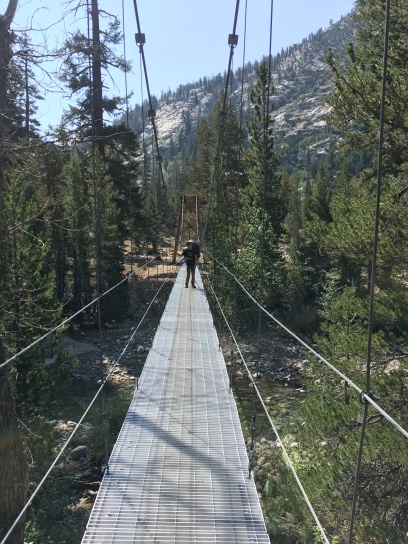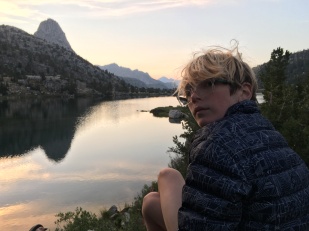Kearsarge Lakes to Onion Valley, 6.5 miles, +1000 feet, -2700 feet
Lesson: Making the Familiar Strange
The biggest payoff of the hike comes when you get off the trail and you find your relationship to the default world palpably recalibrated. That world’s shorthands and ways of operating reveal themselves to you as strange and unnecessary. Beds, cars, and personal hygiene feel uncomfortable, pointlessly juiced up. Squealing at friends you see unexpectedly and pulling across lanes of traffic to talk to them seems completely natural, even necessary. In the aftermath of our Paiute Trail trek, the hard-earned unfamiliarity passed quickly, but the experience was so strong I can still recall what its kinesthetic dimensions. But first came the hike out.
We woke at six and set to breaking camp. The sky inside the Kearsarge Pass, visible to our right, brimmed with heartbreaking blue and morning sun. I groaned my way through the poorly-graded ascent out of the lake basin, relieved to reach the complicated trail junction sign, which pointed the way to the Pass, Kearsarge Lakes, Bullfrog Lake, and Charlotte Lake. The trail improved when we began the actual ascent to the pass: a long traverse followed by a series of switchbacks, then another long traverse and another series of switchbacks.
Close to the top, I found an answer to Day 3’s question about the nature of my spirit quest in the form of a bunch of tiny purple flowers sprouting out of the trail’s rock wall. The sun was cresting over the pass’s ridge; the flowers faced southeast, into the Paiute Trail’s spectacular granite panorama.  Be like the flowers, the mountains said. Fragile, diminutive but in stubborn bloom, steeped in the gorgeous thin air of extreme elevation. As in the Bach motet: Tobe Welt, und springe; Ich steh’ hier und singe, in gar sich’rer ruh. Poorly translated: “rage, world, and attack; I stand here and sing in completely certain peace.” As a person who suffers from anxiety, this sentiment feels noble and only occasionally attainable. Maybe I’d pounded it into my body in the last fifteen days.
Be like the flowers, the mountains said. Fragile, diminutive but in stubborn bloom, steeped in the gorgeous thin air of extreme elevation. As in the Bach motet: Tobe Welt, und springe; Ich steh’ hier und singe, in gar sich’rer ruh. Poorly translated: “rage, world, and attack; I stand here and sing in completely certain peace.” As a person who suffers from anxiety, this sentiment feels noble and only occasionally attainable. Maybe I’d pounded it into my body in the last fifteen days.
At the pass, we doled out the last eight Jelly-Bellies and used the tips of our pinky fingers to search out the last sunflower seeds from the corners of crumpled Ziploc bags.

We were officially out of food. Next stop: Whitney Diner.
The hike down was fast and easy, one we’d done several times before. We passed an increasing amount of day and weekend traffic, people who gleamed with cleanliness and reeked of shampoo and lotions, people with bright clean clothes. We passed a Southern woman leading a mule pack to Charlotte Lake to resupply a large party. She said “yestiday” and tried to make Son the Elder engage in polite conversation, despite his evident reluctance to do so. The air thickened with smoke, heightening the sense that we were descending from a paradise lost. We told the people we passed that there was no smoke at the top; another fluke of wind must have pushed Ferguson smoke into the Owens Valley.

We passed through the boulder field and began the final set of switchbacks alongside the roaring cascade. We could see the Prius, a dusty green mushroom.
And before we knew it, we were changing our clothes and stuffing our packs into the hatchback. We drove through the smoke into Independence and pulled up at the diner. We ordered cheeseburgers, fries, onion rings, coffee, a malted milk, and two root beer floats. And then: oh, the eating.
Stunned by sugar and the booth’s cushioned seats, we staggered out of the diner and prepared for the drive back. I wanted to mail the postcards I’d written on the trail. The post office was five blocks away.

I couldn’t imagine dealing with the inconvenience of getting in the car, driving it, and reparking it, so I walked. When we finally did get in the car and drive, the amped-up pace of it all hit us: everything was so fast, jerky, and aggressive. As we drove out of town, we saw the potty-mouthed millennial and her Gandalf-staffed friend. I screamed. We pulled over and talked about the last five days on the trail.
That night, I couldn’t sleep. I was lit with calories, my clean skin and the soft sheets felt strange, and despite the soft bed I still felt like a bag of bones. We’d pared down our very bodies: we were gaunt and iron-kneed, our eyes stretched by hunger and primed to dazzle with everyday life’s hallucinatory wonder. We were jabbering visionaries, preaching the gospel of the backcountry. The savor restored by the hike worked against us, of course: pizza parties, baking parties, and dinner parties quickly returned us to our default bodies, and before long chocolate cakes, hot showers, and clean clothes seemed pretty damn blase.
But I was also already planning the next hike, which as I write is mere weeks away. While writing these entries, I’ve moved to a new house, where we are battling a large bamboo that serves as a privacy hedge but that also sends runners to every corner of the back garden. I’ve taken to snipping the gathered shoots every morning after biking with the kids to school. Bamboo shoots grow with incredible rapidity. You’ll find a stalk where you cut only yesterday, and a whole raft of them in a corner you didn’t even notice. Bamboo, it occurred to me while using our stubby, rusty clippers to take out some sassy purple stalks by a failing Trader Joe’s basil I’d planted, is like our default minds: a living network moving under the soil, ready to send up terrible, inevitable shoots when you’re sleeping. Meditation, in this little scenario, is digging a trench, severing a whole lot of roots, and inserting a barrier between the mother plant and your garden. But even with barrier in place, you have to check the garden. You have to snip down those shoots, which keep springing up. The hike gives you a chance to snip a lot of shoots and to reinforce that barrier, too, the one that keeps the hungry monster of our default minds from growing back and overrunning the garden.
In his new novel, The Overstory, Richard Powers refers to the madness of late capitalism as “endless suicidal appetite.” It’s good as often as possible to recalibrate appetite — to come back to the barest of what you need so that appetite loosens its grip on you a bit, so that it instead of driving you, it can connect you in gratitude to the world in which you find yourself so inexplicably embedded.



 We lept like gazelles onto the pass, where the Frenchies were waiting for us. They applauded. We ate one Jolly Rancher apiece and let the stiff breeze dry our sweaty shirts.
We lept like gazelles onto the pass, where the Frenchies were waiting for us. They applauded. We ate one Jolly Rancher apiece and let the stiff breeze dry our sweaty shirts. Son the Younger said he felt like he missed something but he didn’t know what. (Welcome to adolescence, son). I felt sad, too, the sadness welling up unexpectedly all afternoon. I wondered whether I’d know before we left the wilderness tomorrow what the mountains had to say to me.
Son the Younger said he felt like he missed something but he didn’t know what. (Welcome to adolescence, son). I felt sad, too, the sadness welling up unexpectedly all afternoon. I wondered whether I’d know before we left the wilderness tomorrow what the mountains had to say to me.
 The Husband was hiking bare-backed, his one t-shirt having ripped entirely away. We breakfasted on oatmeal near a roaring pool where I almost lost a bandana on the fast current. When Son the Younger slipped at a stream crossing and scraped his wrist, we expertly washed it in the stream and bandaged it.
The Husband was hiking bare-backed, his one t-shirt having ripped entirely away. We breakfasted on oatmeal near a roaring pool where I almost lost a bandana on the fast current. When Son the Younger slipped at a stream crossing and scraped his wrist, we expertly washed it in the stream and bandaged it.  The Woods Creek crossing featured a spectacular and purgatorial suspension bridge on which only one hiker was allowed at a time.
The Woods Creek crossing featured a spectacular and purgatorial suspension bridge on which only one hiker was allowed at a time.